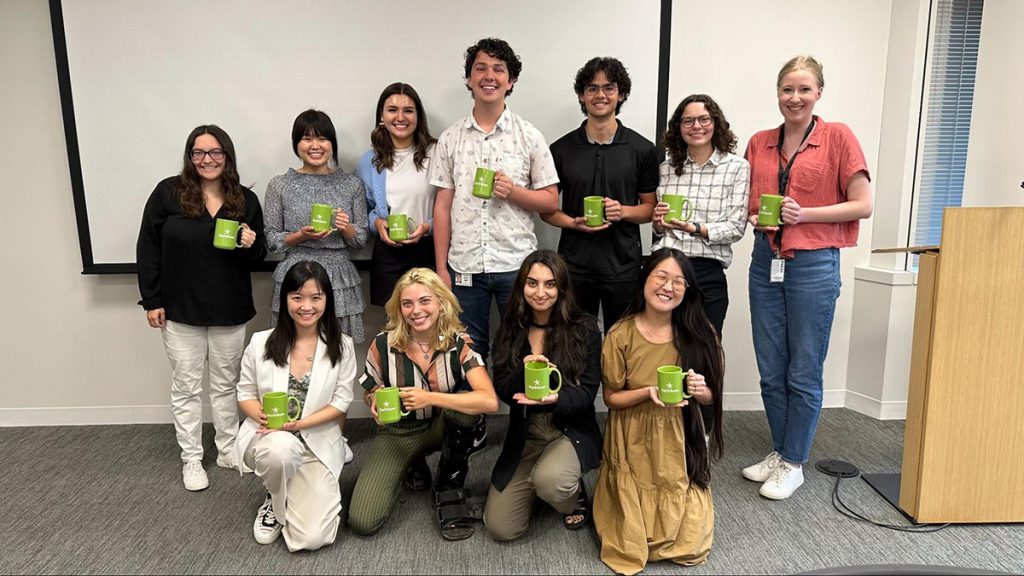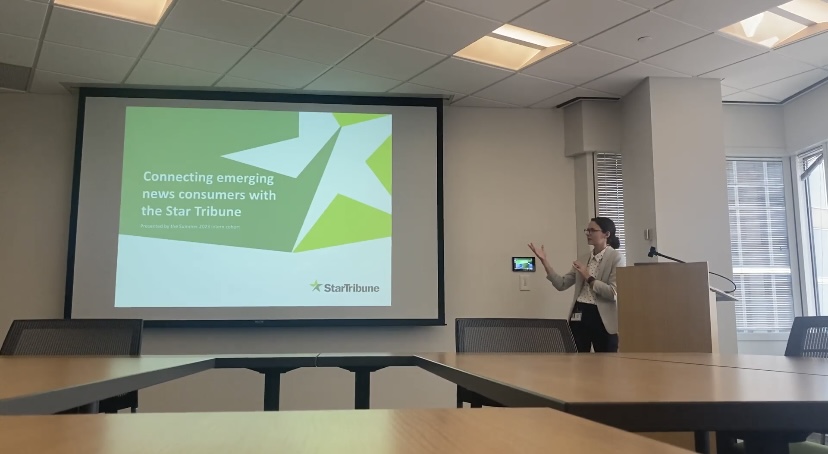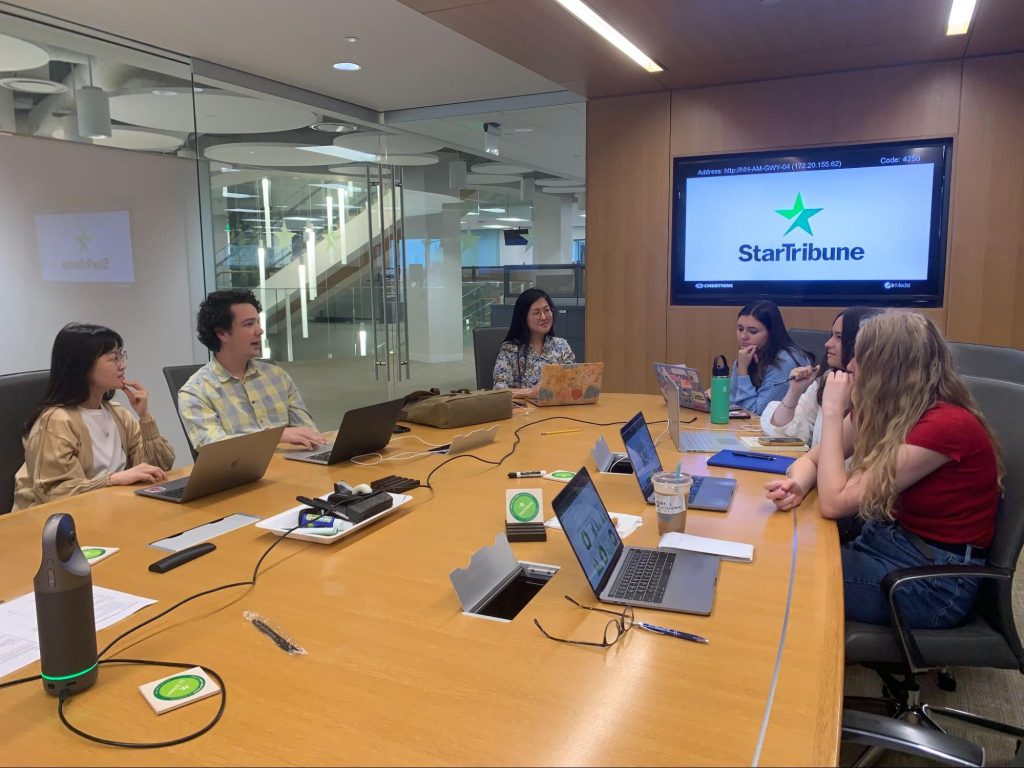
Star Tribune summer interns from left to right: Nicole Gutierrez, Hannah Pinski, Grace Yarrow, Gannon Hanevold, Noah Furtado, Sydney Lewis, Emily Hood, Grace Xue, Angelina Katsanis, Noor Adwan and Auds Jenkins.
The Star Tribune asked its interns to envision the future of the company
Our presentation delivered strategies ranging from expanded revenue models to top-of-funnel engagement to subscriber retention
As a Star Tribune summer intern, I didn’t expect that my intern cohort would meet in our first month with the executive editor, publisher, senior leadership team, owner and board of directors to present our ideas for the future of their company.
Steve Grove began his job as the Star Tribune’s publisher and CEO just a few weeks before the interns arrived. He calls it a pivotal moment in the Star Tribune’s history, as it evolves into a digital-first newsroom and indispensable news source for Minnesotans.
He presented the interns with a prompt: “How might the Star Tribune reach college-age students who are interested in the news, and convert them into loyal readers?”

We were given a four-week deadline and few expectations to prepare our answer. With this simple prompt, company leaders gifted us with the opportunity to run. We sprinted.
Brainstorm
Coordinating the schedules of 12 interns quickly became a challenge, so we started with an asynchronous brainstorm framed around three questions:
- What ST audience problem are we trying to solve?
- How are other organizations solving similar problems?
- How might we solve these problems?
The goal with this framing was to keep the audience (which we named “emerging news consumers”) at the forefront of our strategy and decision-making. Through the brainstorm, the first question evolved into “What do emerging news consumers need that the Star Tribune is not currently delivering?”
The brainstorm gave us lots of ideas, and we pulled out three key points.
- Star Tribune digital subscription prices are unaffordable for many emerging news consumers.
- Emerging news consumers don’t have easy, engaging ways to interact with the Star Tribune.
- Emerging news consumers don’t feel represented in the Star Tribune’s content.
After deciding on these, we set our OKRs and separated into teams to each work on our proposed solutions.
Ideation
The first group proposed an expansion of the Star Tribune’s News in Education program to give more college students and young professionals free or discounted access to the Star Tribune. If implemented, there would be four ways for high schoolers, college students and young professionals to have access:
- News in Education program that gives free access to K-12 schools in Minnesota
- Free one-year digital subscriptions for Minnesota high school graduates
- Selling digital subscriptions to higher educational institutions to provide their students free access
- A tiered pricing system for college students and young professionals that better matches their income
The second group proposed a six-year engagement plan to help young audiences build a habit of engaging with the Star Tribune and give readers clear ways to use their digital access. We explored five new digital products for ages 16, 18, 20 and 22 – tailored to each life stage.
- 16 years old: News literacy crash course that teachers can use to help their students learn about building good news habits.
- 18 years old: College prep newsletter course for people transitioning from high school to a higher educational institution.
- 20 years old: A “Going Out” newsletter tailored to young adults that features events happening in the Twin Cities.
- 22 years old:
- Career prep digital magazine that prepares college graduates for starting their career in the Twin Cities.
- Daily morning push notification that summarizes the news to know for the day. This acts as this audience’s transition to full-fledged news consumers and out of this tailored-product pipeline.
The third group proposed allocating more resources to off-platform strategies like vertical video and building trust through increased transparency with young audiences.
- Investing in the “Behind the Star Tribune” social media accounts
- Standardizing reporter bios to highlight their missions
- Emphasizing short-form social video
- Prioritizing web design and workflow for mobile
Distribution
Once we built these proposals, we prepared a presentation for the senior leadership team, which included the executive editor, other company senior vice presidents and, of course, the publisher. Our 32-minute presentation delivered strategies ranging from expanded revenue models to top-of-funnel engagement to subscriber retention.
A few days later, the publisher asked the interns to prepare a presentation for the Board of Directors’ quarterly meeting. We tailored a shortened version of the presentation and provided a 29-page document outlining the details of our proposals.

Takeaways
Early in the project, we sat in a conference room and I asked everyone, “How much do you want to put into this?” I knew it was a room full of (mostly) reporting interns who didn’t sign up for a four-week crash course in product thinking. Still, the group unanimously decided to put dozens of hours into the project.

When we started, and throughout the process, a few people around the newsroom were skeptical that leaders would listen to the interns. We were told they would clap for us, pat our heads and say “That was cute” as we left the room. But every interaction we had with leadership during this project was exactly the contrary. Newsroom leadership encouraged us to keep going, gave us support and feedback and advocated for us at each step.
All of this isn’t to say that your newsroom should ask the interns to do the same thing. However, I hope you will consider these three things:
- Empower your interns to share their unique, fresh perspectives.
- Listen to them when they give you input.
- Give them a place to run and let them sprint.
The same way newsrooms should invest in young audiences, they should invest in young journalists. Interns are not only the future of your company, they’re also the present.
